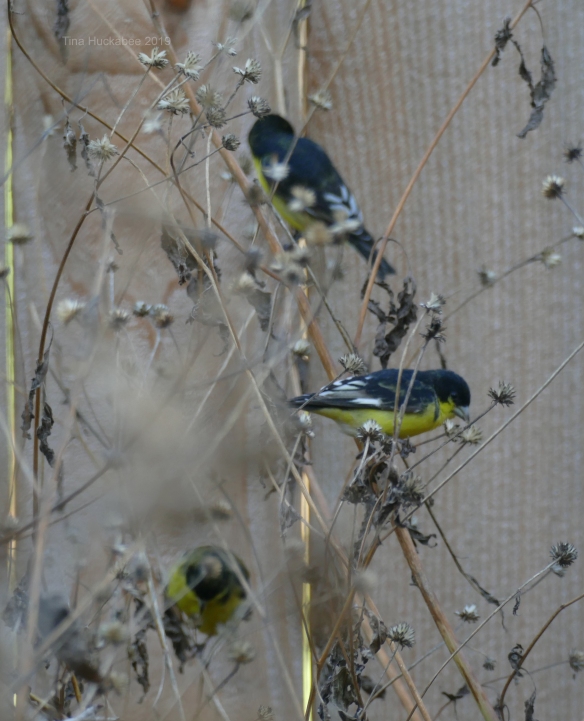It’s November and my garden is still in active flowering and life giving mode. In recent weeks I’ve said a happy howdy y’all to a resurgence of Gulf Fritillary butterfly larvae and a slightly regretful, but ultimately joyful so long ’til next spring to migrating Monarch butterflies. That’s the wildlife gardening way: seasonal change is more than an onslaught of blooms or a conversion of foliage color. It’s also about the cyclic lives of those dependent upon plants for their survival, as well as the fostering of a healthy environment in which wildlife will thrive.
I’m pleased to report that there are scads of Gulf Fritillary, Agraulis vanillae butterfly larvae currently chowing down on my passion vine foliage.
Welcome to the passion vine buffet!
I’m fine with the dining on the leaves, but I wish the cats would leave the budding blooms alone.
Many Gulf fritillary larvae are busily munching, when earlier in the season there was a dearth of larvae activity, which you can read about in my September Wildlife Wednesday post.
I was perplexed at that time, because adult butterflies were clearly laying eggs and some caterpillars were hatching and working the vine. But there were few caterpillars surviving to chrysalis stage and at least some were clearly parasitized during their later instars. That the foliage wasn’t eaten as vigorously as is typical piqued my curiosity, but after some observation and reading, I concluded wasps were the culprits, preying on the caterpillars and reducing their numbers. As with all natural cycles, the tide has apparently turned: there are significantly fewer wasps around and the Gulf Fritillaries are in ascendance.
There’s a passion vine thanksgiving feast afoot.
Actually, that feast involves many feet.
There are lots of caterpillars on the vine and in many sizes, but after all my searching, I’ve only recently spotted one chrysalis. I found this caterpillar late yesterday afternoon. Hanging from its chosen spot in the “J” position, its transformation from larva to pupa isn’t yet complete. Still, it’s a good find and one that confirms the life cycle for this Gulf Fritillary is on track.
UPDATE! I checked the pupa-in-progress at first light this morning and it remained more caterpillar than chrysalis. Only a half hour later, it’s gone full chrysalis! Woo-hoo!
I wish I’d had the time and patience to watch its final transformation.
Those crafty cats–they crawl with determination, sequestering themselves safely away from predators and the nosy gardener wielding a camera.
Toleration of pollinator host plants and their cyclic ugly duckling status is rewarded with Beauty–and in spades.
The other big event in my garden this past month was the autumn migration of Monarch Butterflies, Danaus plexippus. Central Texas lies along the migration pathway of these amazing creatures as they wing toward Mexico in autumn, with a return swing during spring as they flit toward Canada. Once the Monarchs arrive in Central Texas during fall migration, they’ve traveled most of the way to their winter home in the Sierra Madre Mountains in Mexico. As they feed on flowers, they’re fueling up for the remainder of their trip and the winter ahead.
This upside down winged acrobat makes me dizzy as it feeds on the petite blue blooms of the Mexican native, Skyflower, Duranta erecta.
I grow several native plants which are superb pollinator sources and whose blooming has evolved over millennia to partner with Monarch migration. These two Monarchs share the bounty of Frostweed, Verbesina virginica.
In addition to Monarch butterflies, I see a huge variety of bees, butterflies, and flies who visit the Frostweed. It’s also one my personal favorite plants.
Another favorite of pollinators in general and Monarchs in particular, is the Blue mistflower, Conoclinium coelestinum. A fetching member of the Aster family, this perennial grows as a groundcover, blooming sporadically throughout spring and summer and then busting out in blue fuzzy fanfare during September and October–just in time for the migrating Monarchs and anyone else who fancies a sip.
My garden has experienced its first freeze, though the only thing hurt was my poor basil. Drat, that reduces the amount of pesto I will make. As autumn moves forward and winter approaches, there will be further garden goodbyes, but also, critters to welcome during this darker time of the year.
There are always plenty of wild happenings to observe.
Please share your wildlife garden stories and leave a link when you post here. Happy wildlife gardening!
















































